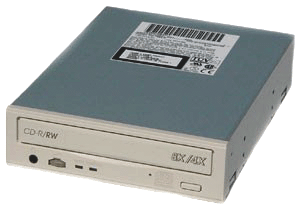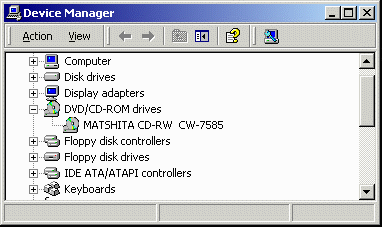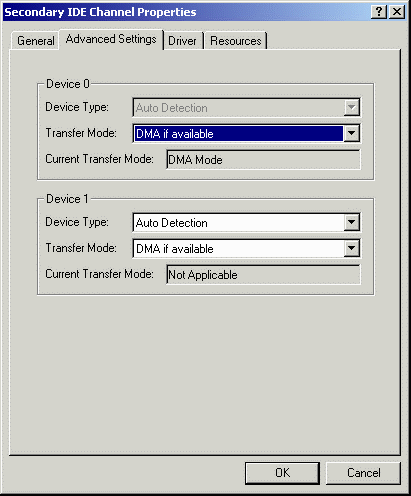 |
||
|
||
| ||
Half a year ago I put my hands on this device, and from that time I recorded more than a hundred CDs, 3 of which got damaged (at least 2 were through the drive's fault). Now it's high time to reveal all its advantages and disadvantages. First comes its specification as usual: 
The drive is produced by Matsushita company, but only in OEM-variant. The company doesn't concern itself with its technical support and doesn't sell it under its trade marks (Panasonic, Technics). In the market you can see it as Compro, Guillemot and Creative (RW8433E model), and in its own OEM-pack (sometimes even with a manual provided). The design is a standard Panasonic. On the rear panel you can find the following jacks: power, IDE, Line Out, Digital Out and Master/Slave/Cable select jumpers. There is no place for a fan, but the drive doesn't heat much. After installation, any OS of Win32 family will identify it as a usual drive. You won't need any additional drives.  The maximum supported data transfer mode is Multi-word DMA Mode 2. And you'd better use the drive in this mode if there are no problems with it. At least with i440BX chipset under Windows 2000 Pro and Windows 98 SE it doesn't cause such.  CD-R recordingWell, after installation the device I had to look for drivers (remember that it's just an OEM-variant). And I think that it's only one of the last Nero versions that could "understand" the drive. For Easy CD Creator you should download an update version, and for WinOnCD you have also to fetch a driver. CloneCD doesn't know this drive so far :( All three programs under Windows 2000 Pro work good together, but there are always something to pay attention to. Before recording, the drive blinks several times and than lights and keeps lighting during the recording. With some discs (now it's only TDK RefleX 700 MBytes*) at 8x Easy CD Creator Deluxe 4.02 buzzes, and WinOnCD 3.7 PE and Nero inform about impossibility of laser calibration. All this leads to the following two conclusions. The first one is that Easy CD Creator is no good here (it buzzes and suggests recording at nonexistent 6x speed). The second one is that light blinks are nothing else than laser calibration, that's way you may not be afraid of maximum speed recording (if it can't calibrate, it won't write), though it's only my guess. I must notice that half a year later the drive refused to write at 8x some other discs as well. Only after lens cleaning it started again to perform. All in all I recorded more than a hundred discs with all 3 programs. Nearly all discs were burnt at 8x except TDK* and soundtracks (which I recorded at 4x just in case). All my friends say that the discs are read quite well, but for that one who owns Pioneer32X Slot-In. To tell the truth, this particular drive can't read RW-discs, that's why it sometimes can read CD-Rs, sometimes it fails. And there it comes across pitfalls in the form of Fujifilm 650 MBytes** disc with dirty-green work surface. So, this disc couldn't be read on this drive, though it works perfectly with others (i.e. TEAC). Then we acknowledged that blue discs recorded with CW-7585 are read not very good either, and green Taiyo Yuden and yellow-green (phthalocyanine based) don't cause problems. Besides, Fujifilm recorded with another drive was read well. What is to blame here? It's vague: it might be CW-7585 which undereburns discs, or another drive that oveburns them, or even it's the technological disc to blame. A little annoying is that CW-7585 offers only 4x and 8x speeds. I'd better play safe and write at 6x instead of 8x. (but 4x isn't an alternative for me since I paid not for it). When recording, all 3 programs appeared troubling. Easy CD Creator shows "6x" in the list of available speeds but writes at 4x at that, and even lies about recording time. Then, all these programs shows 2x speed in the lists, though it's available only if the drive contains a CD-RW. In case of a CD-R it writes at 1x. The drive's buffer possesses 2 MBytes size, what is quite enough for 1.5 s faults with data transfer when recording at 8x. I have some difficulty with it under W2K only when loading new applications. All applications which are loaded before recording process starts (ftp-server with its 0.5 MBytes/s; ICQ, ReGet, Winamp, different IE windows etc.) don't disturb the process. Besides, I wouldn't recommend you to use Netscape Navigator while writing. Computer configuration: Celeron 800 (100x8)/128/Abit BF6/Quantum LB, the drive is on the separate pipeline cable. ReadingIn general, the reading quality is quite good. It has comparable results with drives from TEAC, which are leading here. When coding soundtracks from an audio CD (with some scratches) the audio quality of the obtained files were excellent. Data access speed of this drive is quite low, that's why we won't recommend you to use it often for reading. You'd better add a CD-ROM drive. While reading CW-7585 vibrates and makes much noise if you won't restrain its speed with special programs. However in case of audio and video discs the drive lows the speed and doesn't prevent playback (it means listening via IDE-interface and DAC of the sound card) and viewing. When I bought the device it had only firmware of 1.01 version, and it refused to read some of my discs. Fortunately, the firmware of 1.4 version turned a ring-buoy. You can see a firmware version on many mainboards while loading, in the recording programs, in CDR Media Code Identifier program. Renewed versions may be found on the following sites: Nero, Compro and unofficial site devoted to CW-7585. For the graphs of reading apply to this article. CD-RW recordingIf you use CD-RWs as usual CD-Rs the recording process is very similar. For recorded disc cancellation the recording programs contain a relevant option. This option however turns disabled in case of a working program for packet recording (if the disc is formatted). But the program CDEraser (from the directory where DirectCD was installed) will help you. Unfortunately, I don't know what will happen in case of PacketCD instead of DirectCD. But don't worry since PacketCD doesn't run under Win2K. Do not try to install PacketCD under Windows 2000 - it will cause a system failure. An approbated process of installation of packet recording program is following: first we install WinOnCD 3.7 PE, than goes renewal of PacketCD to DirectCD of 3.01e version from Cequadrat site (without a prior installation of PacketCD). Consequently, we get a system working with UDF. There is only one drawback: a complete disk formatting doesn't work, there might be only a quick one. After installation of DirectCD under W2K you can see the following tab on the driver's properties:  It will help you set Write Speed (1, 2, 4, 8x) and Read Speed (1, 2, 4, 8, 16 and 32x). Interestingly that 16x, which is not mentioned in the specification, works. Unfortunately, you can set Read Speed only for the current disc. After ejecting the disc, the setting will turn to maximum. ConclusionOK, let's call it a day. Our research corresponds to the CD-RW drives roundup: CW-7585 is an average drive, without strong lowlights though. Reading and writing quality is rather good. As for its disadvantages, I'd stress on its loud work while reading and high access time. LinksRetail vendors of Matsushita - Panasonic CW-7585 drive:
Unofficial site devoted to Matsushita - Panasonic CW-7585: Programs for disc recording:
Programs for defining OEM manufacturer and R/RW discs parameters:
See also other articles on our site. *Comments:(CDR Media Code Identifier V1.52)
Write a comment below. No registration needed!
|
Platform · Video · Multimedia · Mobile · Other || About us & Privacy policy · Twitter · Facebook Copyright © Byrds Research & Publishing, Ltd., 1997–2011. All rights reserved. |